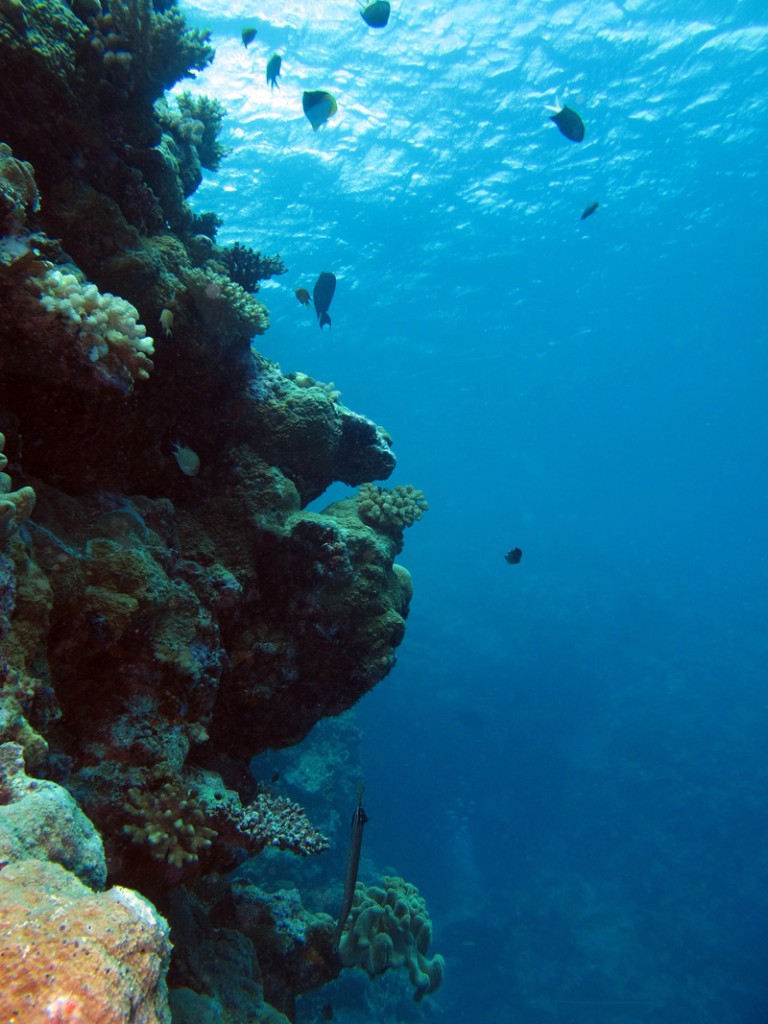The team flew into Cairns on the 13th July (was it the A team?). By the 16th all was in readiness for sea, we cast off and proceeded out of port through the smallest opening you would ever wish to see. After a brief re-fueling stop our brave party ventured forth out into the Coral Sea. Unfortunately the Queensland saying of “Sunny one day, perfect the next” was not in evidence. Our intrepid crew one by one grew quiet and minimum food was consumed over the next few days! The winds grew in strength and the seas followed as we ventured forth (up to 5 metre seas on occasion.) As we approached our first dive site, Bougainville Reef, the enormity of our diving task became apparent. How do you dive on a reef with huge seas sweeping over it from one end to another, unfortunately it wasn’t meant to be and so we headed on to Osprey Reef.
Osprey Reef was a different scenario with a fringing reef that gave reasonable access from the leeward side into a windy but satisfactory anchorage. Finally the wait was over, our first dive was upon us and did not disappoint, with very clear water and a wide variety of fish species, but inverts were a little lacking. 4 surveys were completed on this inner east dive site before we ventured outside our comfort zone and anchor up on the north side of Osprey Reef.
Here is where the real diving took place. Over the next two days, 12 surveys were completed on the edge of a reef that dropped to 1000 metres! Unfortunately doing inverts on a tropical reef does not allow for taking in the sights, but when Toni wasn’t looking I snuck off to take some pictures of something or other. I guess that is partially why the invert surveys took so long! But in retrospect this was to be the highlight diving-wise, of the whole trip. Most sites were made up of the typical, smaller reef fish species (Chromis iomelas, Pomacentrus mollucensis, Chromis atripes) because the crew were unable to get up to the well-known North Horn to see the sharks, trevally and big tuna species, but some of the larger sightings included dogtooth tuna (Gymnosarda unicolor), white-tip reef sharks (Triaenodon obesus) and bumphead parrotfish (Bolbometopon muricatum).

Due to the continued bad weather we reluctantly made our way inside of the outer the reef in the hope of getting some sites that did not have huge seas breaking over them. After coming in through the North Broken Passage we headed for the Flinders Group in the hope of doing some surveys, but alas the underwater visibility turned out to be less than one metre. So we then headed up to Iris Reef, where we were blessed with almost calm conditions, so two surveys were done in milky water of maybe 2-3 metres visibility.
The anchorage there was not really flash so we headed up to Morris Island for the night. Next day we headed for Portland Roads in ordinary conditions where we were storm bound with other fishing boats (and the Australian Customs boat) that complained that it was one of the worst winters in ages. After a day soaking up the atmosphere, we were off once again and this time we managed a sneaky dive on the northern tip of Eel Reef, where once again the viz. was poor and the wind blowing strongly.
We then headed for Farmer Island to anchor for the night ready for an early morning dive. Unfortunately there were a number of crocs in residence which seemed to cool the ardour of the keenest of divers, so next morning after a croc photo session it was once more, up anchor and on our way, this time to dive at Moody Reef where the whole team for the first time hit the water. The surveys came thick and fast for a brief moment in better than expected conditions (visibility-wise anyhow). Although the visibility wasn’t great, the crew were still finding similar numbers of fish species per transect to the outer reef (40-50 species per 250m2) .
That night we spent at Cape Grenville, before heading for Cairncross Island to complete some more surveys. But alas what did we find, but more evidence of our croc friends using this island as a base. From thence we went cruising enjoying the improving weather around Cape York and Thursday Island. But how ironical was it, that the best weather came when the water conditions became very murky and tidal, and our crocodilian friends seemed to dominate all the reefs for mile after mile. But from an ‘old salt’s’ point of view the trip was a ball, the rough weather was a hoot, seeing crocodiles in the wild was even better and diving in really deep water was something to behold!
